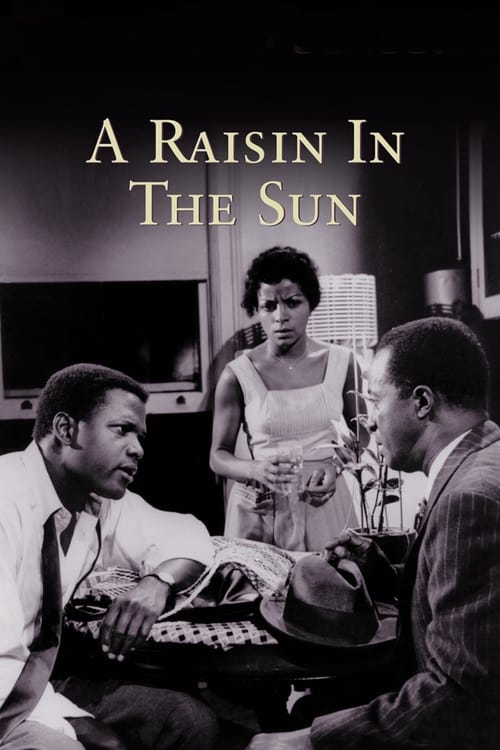In the annals of American cinema, few films have left as profound a mark on both culture and history as A Raisin in the Sun. Originally adapted from Lorraine Hansberry’s groundbreaking 1959 play, the film has transcended its era to become a cornerstone of American storytelling. From its initial release in 1961 to its 2008 television adaptation, A Raisin in the Sun continues to resonate with audiences, offering a poignant exploration of race, identity, and the pursuit of dreams.
A Story Rooted in Real Life

Set in 1950s Chicago, A Raisin in the Sun centers around the Younger family, an African American household grappling with poverty, racial discrimination, and the weight of unfulfilled aspirations. At the heart of the story is Walter Lee Younger (played by Sidney Poitier), a chauffeur whose dreams of financial freedom clash with his mother Lena’s (Claudia McNeil) desire for stability and security. His sister Beneatha (Diana Sands) seeks to redefine her identity through education and cultural exploration, while Ruth (Ruby Dee), Walter’s wife, tries to hold the family together amidst mounting pressures.
The film’s power lies in its ability to humanize these struggles, portraying the Youngers not as caricatures but as individuals navigating the complexities of life in a society that often overlooked their potential. As Hansberry herself noted, the play was inspired by Langston Hughes’ poem Harlem, which asks, “What happens to a dream deferred?” This question echoes throughout the film, shaping the characters’ decisions and the film’s emotional core.
A Cultural Milestone

When A Raisin in the Sun first premiered in 1961, it was a revolutionary work. It was the first play written by an African American woman to be produced on Broadway, and its themes of racial inequality and economic disparity were radical for the time. The film adaptation brought these themes to a wider audience, sparking conversations about the American Dream and the systemic barriers that prevent marginalized communities from achieving it.
The film’s portrayal of the Younger family also challenged prevailing stereotypes about Black families in Hollywood. Instead of depicting them as either tragic or comic relief, Hansberry and the filmmakers presented a nuanced, multi-dimensional portrait of a family striving for dignity and opportunity. This approach helped pave the way for more diverse representation in American media.
The Impact of Performance

One of the most striking aspects of A Raisin in the Sun is the strength of its performances. Sidney Poitier’s portrayal of Walter Lee remains one of the most iconic in American cinema, capturing the character’s frustration, ambition, and vulnerability. His performance earned him critical acclaim and helped solidify his status as a trailblazer for Black actors in Hollywood.
Ruby Dee and Claudia McNeil delivered equally powerful performances, bringing depth and authenticity to their roles. Their chemistry with Poitier created a sense of realism that made the Younger family feel like real people, not just characters in a story.
The film’s success was not only due to its acting but also to its direction and cinematography. David Petrie’s direction emphasized the claustrophobic nature of the Younger family’s living space, reflecting the tension and pressure that define their lives. Charles Lawton Jr.’s black-and-white cinematography added to the film’s somber tone, reinforcing the sense of struggle and perseverance.
A Legacy That Endures
Despite being over half a century old, A Raisin in the Sun remains relevant today. Its themes of racial injustice, economic inequality, and the search for identity continue to resonate with modern audiences. The film has been adapted multiple times, including a 2008 television version starring Sean Combs, Audra McDonald, and Phylicia Rashad. Each adaptation brings new perspectives to the story, ensuring its continued relevance.
The 2008 version, directed by Kenny Leon, received praise for its faithful yet fresh interpretation of Hansberry’s work. It highlighted the evolving nature of the Younger family’s struggles while maintaining the core message of the original play. The cast, including Combs and McDonald, brought a new energy to the film, making it accessible to a new generation of viewers.
Critical Acclaim and Recognition

Upon its release, A Raisin in the Sun was met with widespread critical acclaim. Critics praised its powerful performances, insightful script, and compelling storytelling. The film was also recognized for its contribution to American cinema, earning several awards and nominations.
In addition to its artistic merits, the film played a significant role in advancing the careers of its cast and crew. Sidney Poitier, who had already gained fame for his role in Cry, the Beloved Country, used A Raisin in the Sun to further establish himself as a leading actor in Hollywood. The film also provided opportunities for other Black actors and filmmakers, helping to diversify the industry.
The Importance of Representation
One of the most enduring legacies of A Raisin in the Sun is its impact on representation in media. By centering the lives of an African American family, the film challenged the dominant narratives of the time and offered a platform for underrepresented voices. This legacy continues to influence contemporary storytelling, inspiring new generations of filmmakers and writers to tell diverse stories.
The film’s emphasis on the importance of family, community, and resilience has also resonated with audiences across different backgrounds. It serves as a reminder of the power of storytelling to connect people and foster understanding.
Conclusion
A Raisin in the Sun is more than just a film; it is a cultural touchstone that continues to inspire and educate. Its exploration of race, identity, and the American Dream remains as relevant today as it was when it first premiered. As we reflect on its legacy, it is clear that the Younger family’s story is one that will endure for generations to come.
For those interested in learning more about the film and its impact, there are numerous resources available, including books, documentaries, and academic analyses. Whether you are a longtime fan or a newcomer to the story, A Raisin in the Sun offers a powerful and thought-provoking experience that is well worth exploring.
Stay updated with the latest news and insights into the world of American cinema and culture. Explore today’s headlines and discover what’s shaping the future of storytelling in the United States.











More Stories
US Trending News: The History and Legacy of Zoo York in Streetwear Culture
US Trending News: Exploring Zach Top Greensboro
US Trending News: Youngboy Concert in Birmingham: What to Know Before You Go